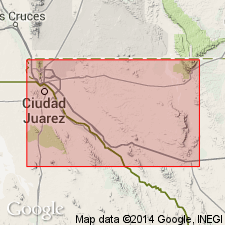
- Usage in publication:
-
- Fusselman limestone*
- Modifications:
-
- First used
- Dominant lithology:
-
- Limestone
- AAPG geologic province:
-
- Orogrande basin
Summary:
First used; intent to name not stated, and origin of name not discussed. No type locality designated. Outcrops in Franklin and Hueco Mountains, El Paso Co, TX in Orogrande basin. Is a massive, whitish magnesian limestone approximately 1,000 ft thick. Overlies Middle and Upper Ordovician Montoya limestone (new) apparently conformably, although in one locality fragments of the underlying limestone included in Fusselman is evidence of an unconformity. Overlying Devonian and Lower Carboniferous (Mississippian) rocks absent in trans-Pecos TX, and the Silurian, where present, is overlain by the Upper Carboniferous (Pennsylvanian). In Franklin and Hueco Mountains, the Pennsylvanian Hueco limestone immediately overlies Fusselman apparently conformably in spite of the great hiatus indicated by their ages (in Van Horn quad, a conglomerate is present at base of Hueco). Throughout greater part of formation fossils are scarce, but at a few horizons they are very abundant. Commonest form is a species of radially plicated pentameroid shell which, with Amplexus and Favosites (determined by Ulrich) proves that the upper Niagaran stage of the Silurian is here represented. Gordon and Graton (1906) have recently found Silurian fossils in Silver City region and at Lake Valley, NM; and Taff's (1903) Hunton formation in OK also contains a Silurian fauna. But with these exceptions, Fusselman is only known occurrence of Silurian rocks in southwestern U.S.
Source: GNU records (USGS DDS-6; Denver GNULEX).
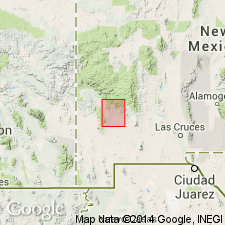
- Usage in publication:
-
- Fusselman limestone*
- Modifications:
-
- Areal extent
- AAPG geologic province:
-
- Basin-and-Range province
Summary:
Fusselman limestone present in Silver City quad, Grant Co, NM in Basin-and-Range province. Top of underlying Ordovician Montoya so closely resembles Fusselman beds that the unconformity between Montoya and Fusselman--indicated by fossils--is not recognized in this quad. Montoya and Fusselman therefore mapped together, with top of Fusselman at base of Devonian Percha shale; base of Montoya unconformably overlies Ordovician El Paso limestone. Fusselman is of Silurian age. Geologic map.
Source: GNU records (USGS DDS-6; Denver GNULEX).
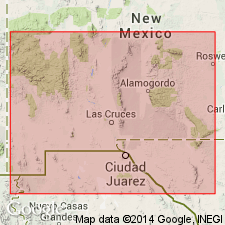
- Usage in publication:
-
- Fusselman limestone
- Modifications:
-
- Revised
- Areal extent
- AAPG geologic province:
-
- Orogrande basin
- Basin-and-Range province
Summary:
Fusselman limestone revised in that it is overlain by the Middle Devonian Canutillo formation (first used, this report) in Franklin Mountains, El Paso Co, TX in Orogrande basin. Fusselman contains a characteristic Niagaran (Middle Silurian) fauna. Its thickness in Franklin Mountains is extremely variable. Fusselman crops out on some of the highest summits of the Franklin Mountains--its greatest thickness is in these mountains. In Oscura Mountains (Socorro Co, NM) it is entirely absent, while in the Van Horn district it has recently been reported as possibly being present. Does not exceed 100 ft in thickness in the region near Silver City (Grant Co, NM in Basin-and-Range province). Fusselman forms the dip slope of the higher portion of the Franklin Mountains opposite Vinton, TX and is overlain by either the Middle Devonian sediments or, in places, by the Pennsylvanian Magdalena formation (revised). Overlies Upper Ordovician Montoya limestone. Fusselman is of Middle Silurian (Niagaran) age. Stratigraphic chart.
Source: GNU records (USGS DDS-6; Denver GNULEX).
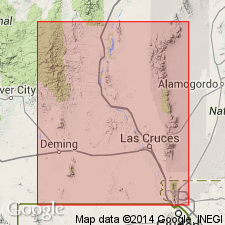
- Usage in publication:
-
- Fusselman dolomite
- Modifications:
-
- Revised
- AAPG geologic province:
-
- Orogrande basin
Summary:
Revised to separate beds formerly mapped together. Lower beds of Fusselman dolomite removed and now termed Cutter formation (new) of Montoya group. Fusselman poorly exposed in report area; its distribution in southern NM imperfectly understood. Overlies Cutter formation of Montoya group; underlies Percha formation. Is suggested to be Niagaran or Late Silurian in age based on correlation with lithologically similar units in nearby localities.
Source: GNU records (USGS DDS-6; Denver GNULEX).
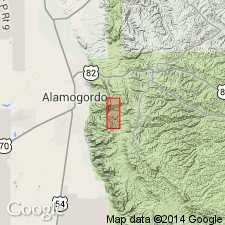
- Usage in publication:
-
- Fusselman(?) formation
- Modifications:
-
- Revised
- Redescribed
- Dominant lithology:
-
- Limestone
- Dolomite
- AAPG geologic province:
-
- Orogrande basin
Summary:
Rocks assigned to the lower member of the Fusselman limestone in the Sacramento Mountains, Otero Co, NM in the Orogrande basin by Darton (1917) are removed from the Fusselman and named Valmont dolomite. Rocks called upper member of Fusselman by Darton are designated Fusselman? because correlation of these rocks with type Fusselman is uncertain. Change of designation from limestone to formation made because of the abundance of dolomite as well as limestone in the Fusselman. Consists of gray, dark-weathering, cherty dolomite that is resistant to erosion, forms ledges and benches. Ranges from medium to coarsely crystalline. Chert occurs as nodules and irregular masses. Disconformably underlies Onate formation. Nomenclature chart, columnar section. Section 42 ft thick measured in sec 6, T17S, R11E, where the formation is composed only of gray finely crystalline dolomite. Age in report area is Early Silurian, Alexandrian. Fossils (anthozoans, bryozoans, brachiopods, mollusks) listed. Geologic map.
Source: GNU records (USGS DDS-6; Denver GNULEX).
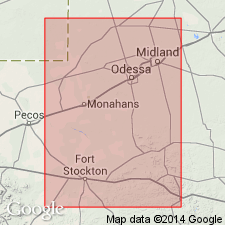
- Usage in publication:
-
- Fusselman Formation
- Modifications:
-
- Contact revised
- AAPG geologic province:
-
- Permian basin
Summary:
Upper contact revised in that beds called "Silurian shale," "Upper Silurian," and "Green Silurian" in subsurface of West TX named Wristen Formation. The lower member of the Wristen named Wink Member rests on Fusselman. Wristen identified in subsurface of Ward, Winkler, Andrews, Pecos, and Upton Cos, TX in the Permian basin. Cross sections. Correlation chart. Of Early and Middle Silurian age.
Source: GNU records (USGS DDS-6; Denver GNULEX).
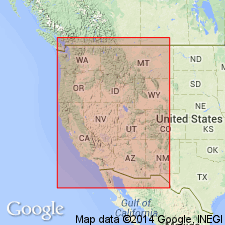
- Usage in publication:
-
- Fusselman Dolostone*
- Modifications:
-
- Redescribed
- Dominant lithology:
-
- Dolostone
- AAPG geologic province:
-
- Orogrande basin
Summary:
Is redescribed as dolostone. The name "dolostone" is used for rocks composed predominantly of the mineral "dolomite" on Figure 2 and throughout this chapter, although in the literature it has been common practice to use dolomite rather than dolostone in formal names of dolomitic formations and members. Occurs in stratigraphic column for southern NM (Orogrande basin). Unconformably above Montoya Group (Upper Ordovician); unconformably below Onate Formation (Middle Devonian). Assigned to Llandoverian and Wenlockian Series (Lower Silurian).
Source: GNU records (USGS DDS-6; Denver GNULEX).
For more information, please contact Nancy Stamm, Geologic Names Committee Secretary.
Asterisk (*) indicates published by U.S. Geological Survey authors.
"No current usage" (†) implies that a name has been abandoned or has fallen into disuse. Former usage and, if known, replacement name given in parentheses ( ).
Slash (/) indicates name conflicts with nomenclatural guidelines (CSN, 1933; ACSN, 1961, 1970; NACSN, 1983, 2005, 2021). May be explained within brackets ([ ]).

